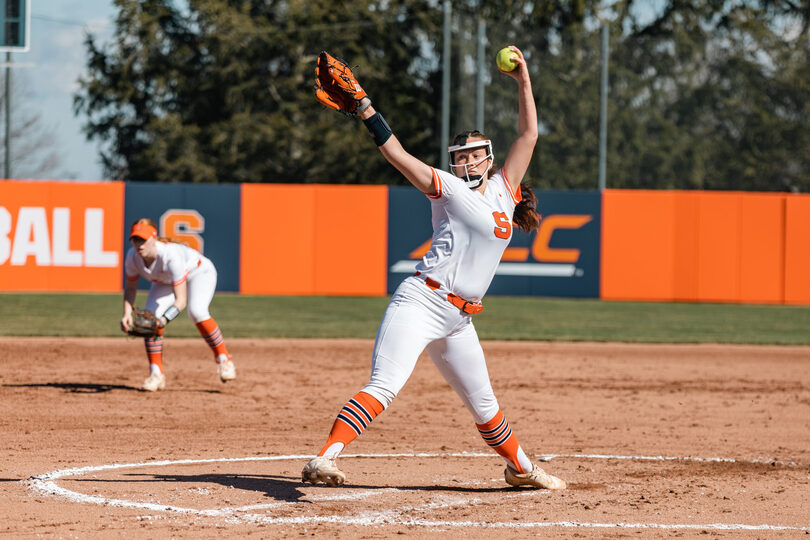Syracuse’s pitching struggles stem from poor command, inconsistency

Joe Zhao | Staff Photographer
SU’s pitching struggles stem from its inability to consistently strike out batters and limit walks, ranking 231st in the NCAA with a 1.21 K/BB ratio
Get the latest Syracuse news delivered right to your inbox. Subscribe to our sports newsletter here.
Madison Knight couldn’t find the strike zone on April 1 against Louisville. Syracuse was down 4-0 in the sixth inning when she loaded the bases after walking three consecutive batters.
Taylor Roby – who already hit two home runs across the day’s doubleheader – looked to extend the Cardinals’ lead. But when Knight needed to be on target, she was wild.
After falling behind in the count 2-0, Knight tossed one right down the middle of the plate. Roby belted a grand-slam to dead center field, leading to an eventual 8-0 Louisville run-rule win.
“I don’t really care about solo shots,” head coach Shannon Doepking told the NewsHouse following the game. “It’s the walks before the home runs that are killing us… The problem becomes when solo shots turn into grand slams.”
Syracuse’s pitching staff has struggled with command throughout the season, ranking 234th in Division I with a 4.57 ERA. The Orange’s top pitchers, Lindsey Hendrix and Knight, have poor strikeout/walk ratios (K/BB) at 1.33 and 1.35, respectively, which rank outside the top 150 in college softball.
Fielding Independent Pitcher (FIP) is an advanced pitching metric similar to ERA, but it focuses on events that a pitcher has the most control over: strikeouts, walks, hit-by-pitches and home runs. FIP doesn’t account for batted ball outcomes because the results fluctuate depending on independent factors like luck and sequencing.
As a team, Syracuse’s FIP is 5.25 – 0.79 points higher than its ERA – because strikeout and walk rates are heavily weighted into the metric. The Orange have accumulated 204 strikeouts and 172 walks, resulting in a 1.21 K/BB, 231st in the NCAA. Pitt, NC State and Georgia Tech are the only Atlantic Coast Conference teams with a higher FIP than the Orange.
In the first game of its April 15 doubleheader against North Carolina, the Orange’s poor pitching was on full display. Across six innings, Hendrix and Kaia Oliver struck out three batters and walked four – a disastrous 0.75 K/BB.
In the top of the second inning, Syracuse took an early 1-0 lead, but UNC charged back in the bottom half of the inning. After a leadoff bunt single, Hendrix retired the following two batters. But a five-pitch walk extended the inning and the Tar Heels capitalized. Hendrix allowed four straight hits, giving UNC a 4-1 lead that they wouldn’t relinquish.
While Syracuse’s pitching has struggled throughout the season, it dominated its most recent series, a three-game sweep of Lafayette last weekend.

Jacques Megnizin | Design Editor
Across two starts, Knight pitched 13 innings and gave up three earned runs. Hendrix started one game and pitched seven innings, giving up two earned runs. Despite facing a weak Lafayette team with a 6-32-1 record, Knight and Hendrix posted much improved 4.0 and 5.0 K/BB rates, respectively, which are significantly better marks than their season averages.
Against the Leopards, Knight and Hendrix struck batters out at a high rate, issuing minimal walks while allowing just one home run in 20 innings pitched. Still, if opposing batters put balls in play at a high rate, it increases the pressure put on the defense and one error could change the game.
Versus Louisville, Rebecca Clyde hit a two-run single in the fourth inning. But errant throws to home plate and then to second base allowed Clyde to circle the bases, cutting the Orange’s deficit from four to one.
Hendrix forced Daisy Hess to hit a routine ground ball to shortstop while trying to get out of a two-out jim with a runner on third in the top of the seventh. But the ball kicked off Kelly Breen’s glove, allowing the run to score and Hess to reach base safely, giving Louisville a much-needed insurance run.
In the bottom half of the inning, with a two-run deficit instead of a one-run deficit, the Orange were able to get the tying run to the plate, but they were held scoreless, losing 5-3. The pitching was OK but this time, an error ruined their chances.





